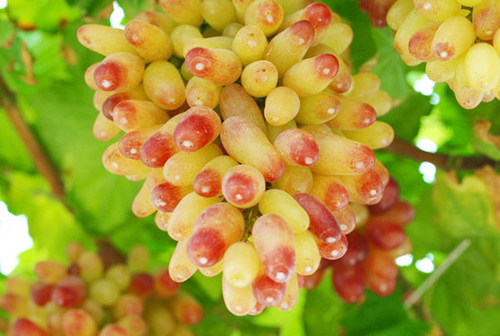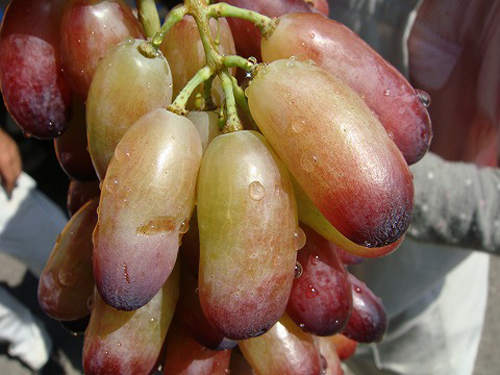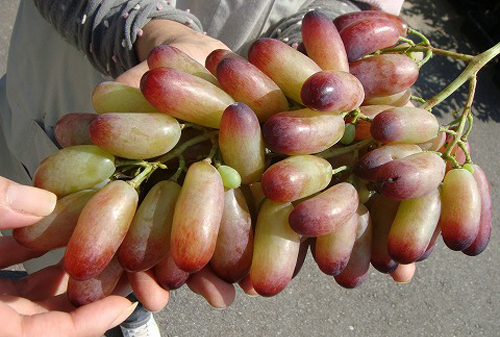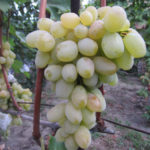Grape variety Manicure finger
Finger manicure (Manicure Finger), which means "manicured finger" - is very popular abroad, and in recent years in our country, a picturesque variety of table grapes originating from the Land of the Rising Sun. It got its name for the elongated greenish-golden berries with reddish pigmentation at the tips, which, in fact, resemble nails with a manicure.
To obtain it, Japanese researchers crossed two local varieties Unicorn and Baladi in 1984. Having sown hybrid seeds, in 1988 they selected our hero from the total number of seedlings precisely for his decorative effect, which amazed the breeders after the first fruiting. Thanks to this visual appeal, the variety quickly spread throughout the countries of East Asia, and once in China, from there it began its triumphant march around the world. In the 2000s, the form also gets into our country, and the interest in it turns out to be so great that winegrowers are ready to pay very large sums of money for the cherished seedlings.

Over time, the excitement begins to decrease somewhat, which is largely facilitated by the realization that, in addition to the magnificent aesthetic properties of fruits, there are also economic ones. And here Manicure finger does not look so confident anymore. In particular, it is distinguished by a certain delicacy in terms of the resistance of the vine to winter frosts, as well as resistance to common fungal diseases. In addition, it cannot boast of an early entry into fruiting, and even having begun to form clusters, it unpleasantly surprises its owners with very modest yield indicators in the first years.
Such contradictions confuse winegrowers. Those of them who are just planning to plant a variety in their area begin to doubt the advisability of such a step. The owners of the exotic hybrid were divided into two camps - some fully protect their pet, others threaten to uproot it or re-graft it. But, be that as it may, the army of fans of the Japanese guest continues to be quite impressive, and even gradually grows new members.
Agrobiological properties
Plants have a very high vitality and vigor of growth. The crown of a young shoot is smooth, shiny, without pubescence. Anthocyanin tones may appear on it and young leaves. A typical leaf is large, rounded in shape, consists of three or five lobes, the dissection between which is quite strong. The surface of the leaf is reticulate-wrinkled, rich green with prominent light or slightly pinkish veins, the edges of the lobes are often raised upward. The upper side cutouts are deep, open slit-like, or have the shape of a reentrant corner. The lower notches are very shallow, often barely outlined, mostly V-shaped. The petiole notch is open lyre-shaped or vaulted, with a pointed bottom. Petioles in length do not exceed the size of the main vein of the leaf; their color is greenish, often with reddish patches. The teeth along the perimeter of the leaf blade are generally large, but uneven in size, triangular and saw-shaped, with curved edges and rounded apices. The flowers are bisexual, which allows them to pollinate with their own pollen without unnecessary difficulties even in unfavorable weather conditions during flowering, forming a well-executed brush without a tendency to pea berries. Scattering of inflorescences and ovaries behind the Japanese hero was also not noticed. The growth of the current year is maturing slowly, and far from the entire length. The ripe part of the shoots turns brown.

Manicure finger clusters can reach very significant sizes, up to 30 - 35 cm long and weighing up to one and a half kilograms, however, the main condition for this is the accumulation of large volumes of perennial wood by the bush, which is achieved only in adulthood.The brushes of the first harvests, which appear only in the third - fourth year after planting, are relatively small - weighing 300 - 500 grams, large-fruited then grows every year. The length of the herbaceous comb is moderate, the color is greenish, often with anthocyanin inclusions. Berries, up to 70 - 100 per cluster, are magnificent in appearance. Their shape is elongated-curved, in length they can grow up to 50 mm, in diameter 20 mm. The average weight of a grape is 12 - 14 grams, some reach 20 g. The color, as already mentioned, is very original - going from golden to red at the tip. At the same time, after full ripening, the whole berry can acquire a completely red color with a darker edge. The pulp of the fruit is quite dense, fleshy, some growers even note its crunch when chewed. The taste is pleasant, harmonious, without harsh nuances in the aroma and aftertaste. The berries are distinguished by good sugar accumulation, about 17 - 18 g / 100 ml of juice, with a titratable acidity of about 6 g / l. The peel is inseparable from the pulp, very thin, which is why it is almost invisible during meals. The seeds are present, in number 1 - 2 in the berry, but do not have a serious negative effect on the palatability of the fruit. In general, the tasting ratings of this grape are high.
The resulting crop is intended for fresh consumption. The variety has everything you need to fall in love with the consumer, and this is confirmed by farmers who try to cultivate the variety for sale. Buyers do not let the finger lie stale on the shelves, predictably showing interest in it due to its unusual colors. The commercial use of the variety is also favored by the excellent transportability of the bunches, which do not lose their presentation even after long distance transportation. However, a negative factor is the relatively late ripening of grapes, as a result of which it has to withstand fierce competition on the market with old, inexpensive varieties. In private households where the culture is grown for their own consumption, our hero will become the decoration of the site and the pride of its owners. Grown with care and proper care, it is capable of producing a significant harvest, which in excess is enough for direct consumption. In this case, the surplus of grapes can be used for canning, making compotes, preserves, jams and other preparations for the winter, wonderful in taste and color, which will be very useful during the period of deficiency of vitamins and microelements.

By the time of fruit ripening, the Japanese variety belongs to the mid-season, the harvest of which in the south of our country begins in mid-September. From the moment the eyes wake up to the onset of the removable ripeness of the berries, 130 - 140 days pass, and the sum of the required active temperatures is 2700 - 2800 ° C. With such indicators, the variety has no special prerequisites for moving north of traditional viticultural zones, which, however, is not facilitated by the moderate frost resistance of the vine, which does not exceed minus 22 ° C. For this reason, domestic growers cultivate an exotic form with insulation for the winter, even where the harvest has time to ripen well. To do this, they use when growing traditional non-standard covering forms in the form of a multi-arm fan or an inclined cordon. Such schemes make it easy to remove the vine from the trellis in the fall, and return it to its place in the spring without damage.
The yield of the variety grows relatively slowly, but in the end it is capable of reaching very significant values. From an adult, well-developed bush, it is quite possible to get up to 15 - 20 kilograms of grapes. Its predisposition to overloads is not high, and therefore rationing of yield is reduced only to competent spring pruning and the subsequent fragmentation of weak and sterile shoots. Only in large-sized bushes that form clusters of the corresponding size, thinning of inflorescences is required, because the shoot is not able to “pull out” more than one massive brush. Fruit arrows are cut into 6 to 8 buds. During the growing season, it is recommended to carry out pinching.
Resistance to diseases in plants is low, and therefore, to protect the vineyard, multiple, up to 4 - 5 times per season, complex fungicide treatments are carried out. The berries are not prone to cracking, but from wasps, clusters should be placed in individual protective bags.








